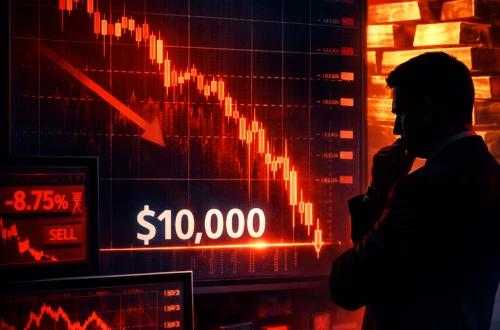How to Do Technical Analysis on Crypto
Summary:
This article explains how to perform technical analysis (TA) on cryptocurrency markets, focusing on tools and strategies suitable for novices. It covers the fundamentals of chart patterns, indicators, and trading psychology while highlighting why TA matters for identifying trends and entry/exit points in volatile markets. You’ll learn how to interpret price data, recognize signals like support/resistance, and mitigate risks. The guide also addresses common pitfalls and limitations of TA in crypto, emphasizing practical implementation for traders.
What This Means for You:
- Empower decision-making with data: TA helps you avoid emotional trades by relying on historical price patterns. Start with simple tools like moving averages to spot trends before risking capital.
- Actionable risk management: Always pair TA with stop-loss orders to limit losses. For example, place stops 5-10% below support levels identified on 1-hour or daily charts.
- Identify high-probability trades: Combine RSI (overbought/oversold signals) with volume analysis to confirm breakout opportunities. For instance, a rising RSI + increasing volume often precedes bullish momentum.
- Future outlook or warning: While TA can improve trade timing, crypto markets are heavily influenced by macro events (e.g., regulations, Bitcoin halvings) that indicators can’t predict. Never rely solely on TA—diversify strategies and stay updated on fundamentals.
Explained: How to Do Technical Analysis on Crypto
Understanding Technical Analysis Basics
Technical analysis (TA) evaluates price movements and trading volume to forecast future behavior. Unlike fundamental analysis, which assesses project value, TA focuses purely on market data. Crypto’s 24/7 markets and volatility amplify opportunities but require disciplined strategy.
Core Tools for Crypto TA
1. Candlestick Charts & Patterns
Candles display open, high, low, and close (OHLC) prices for a given period. Key patterns include:
- Bullish Engulfing: A green candle fully “engulfs” the prior red candle, signaling reversal.
- Head and Shoulders: Predicts trend exhaustion (e.g., a peak followed by lower highs).
2. Support & Resistance Levels
Support is where buying pressure halts declines; resistance is where selling pressure caps rallies. Breakouts above resistance or below support often trigger sharp moves.
3. Indicators & Oscillators
- Moving Averages (MA): Smooth price data to identify trends. A 50-day MA crossing above 200-day MA (“Golden Cross”) signals bullish momentum.
- Relative Strength Index (RSI): Measures overbought (>70) or oversold (
- MACD (Moving Average Convergence Divergence): Tracks trend strength. Signal line crossovers indicate buy/sell opportunities.

Step-By-Step TA Process
- Choose a Time Frame: Scalpers use 5-15min charts; swing traders focus on 4-hour/daily charts.
- Spot the Trend: Use trendlines or MAs to identify uptrends (higher highs/lows) or downtrends.
- Identify Key Levels: Mark recent support/resistance zones on the chart.
- Apply Indicators: Confirm signals with 2-3 tools (e.g., RSI + volume).
- Set Entry/Exit Points: Enter trades near support with stop-loss below. Take profit at resistance or using a 2:1 reward/risk ratio.
Limitations of TA in Crypto
- TA works best in trending markets but struggles during low-volume consolidation.
- “Black swan” events (e.g., exchange hacks) cause erratic price movements TA can’t anticipate.
- Indicators are lagging—they react to past data, not predict the future.
Psychological Discipline
Even accurate TA fails without emotional control. Stick to predefined rules, avoid FOMO (Fear Of Missing Out), and never risk more than 1-2% of capital per trade.
People Also Ask About:
- Does technical analysis work for cryptocurrencies?
Yes, but with caveats. Crypto’s high volatility and speculative nature amplify patterns, making TA useful for short-term trades. However, unique risks like regulatory news require combining TA with fundamental awareness. - What is the best time frame for crypto TA?
Depends on goals: Day traders use 15-minute to 1-hour charts; long-term holders analyze weekly/monthly trends. Multi-timeframe analysis (e.g., checking daily charts for context before 1-hour entries) improves accuracy. - Can I do TA with free tools?
Yes. Platforms like TradingView offer free charting with basic indicators. Paid tiers add advanced tools, but beginners can start with RSI, MAs, and Fibonacci retracements. - How to predict crypto price with TA?
TA identifies probabilities, not guarantees. For example, a symmetrical triangle breakout may target a price rise equal to the triangle’s height. Always confirm with volume spikes. - What’s the difference between TA and fundamental analysis (FA) in crypto?
TA studies price charts; FA evaluates project viability (team, tokenomics, adoption). Combine both—use FA to pick assets and TA to time entries.
Expert Opinion:
Technical analysis is a valuable toolkit but not infallible—crypto markets are prone to manipulation and external shocks. Always prioritize risk management over chasing gains. Tools like backtesting on historical data can validate strategies, but remain skeptical of “guaranteed” indicators. As AI and algorithmic trading grow, retail traders must adapt by blending TA with on-chain metrics (e.g., exchange outflows) for an edge.
Extra Information:
- TradingView: A powerful charting platform with crypto-specific tools and community ideas.
- Binance Academy: Free guides on TA basics and crypto market structure.
- CoinMarketCap: Tracks crypto prices, volumes, and indicators for trend spotting.
Related Key Terms:
- how to read crypto charts for beginners
- best technical indicators for cryptocurrency trading
- crypto support and resistance strategy
- how to use RSI for Bitcoin trading
- backtesting crypto trading strategies
- technical analysis vs fundamental analysis crypto
- advanced crypto chart patterns explained
#technical #analysis #crypto
*Featured image provided by Pixabay




